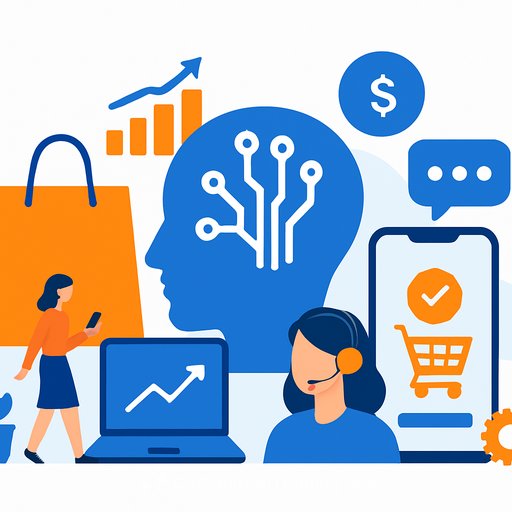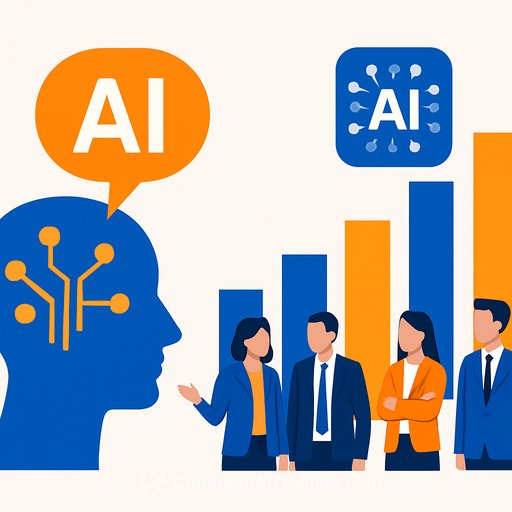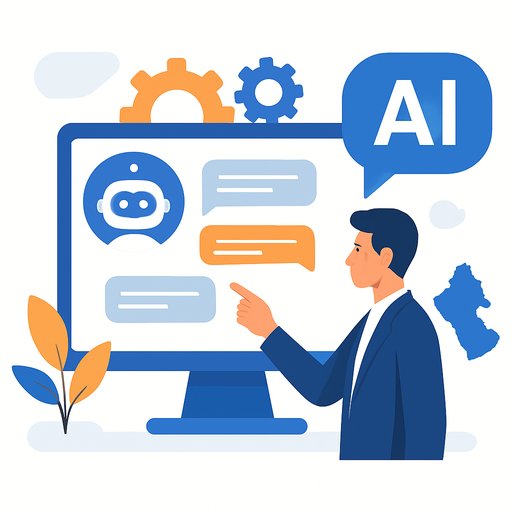Generative AI for Ecommerce: From Sales Forecasts to 24/7 Customer Support
AI is no longer a side project. It's the backbone of how online stores sell, support, and scale. The market for generative AI in ecommerce is projected to hit $110.8B by 2030, with potential to add $400-$660B in value to retail through productivity gains. And yes-35% of purchases on Amazon are already tied to AI-driven recommendations.
If you run Sales or Customer Support, this is good news. You can ship more personalized experiences, fix the slow parts of your process, and keep customers happy at any hour-without bloating headcount.
Key Takeaways
- Economic upside: AI adds 1.2-2.0% productivity across retail, unlocking $400-$660B in value.
- Personalization that pays: Hyper-personalization boosts revenue by 10-15% on average.
- Operational wins: Up to 50% fewer forecast errors and 25-40% lower supply chain costs.
- Support that never sleeps: Sentiment-aware chatbots cut escalations by up to 40%.
- Content at scale: Automate product copy, visuals, and ads in hours-not months-while staying on-brand.
Why Generative AI Is Reshaping Ecommerce
Most stores still run on static pages, basic filters, and rigid search. Shoppers expect better. Generative AI closes the gap between what customers want and what your team can deliver.
Generative AI vs. Traditional AI
Traditional AI analyzes. Generative AI creates. It writes product descriptions, answers customers, drafts emails, and produces visuals that match your brand. Today, traditional AI drives most of the value in retail, but by 2029, generative AI is expected to create the majority of new economic impact.
Retailers that adopt it early already see faster growth-small and mid-size companies using gen AI grow revenue 31% faster than peers.
Customer Experience and Ops Impact
- Personalization: 69% of customers buy more when experiences feel customized. AI builds those touchpoints from real behavior, not guesses.
- Support: AI assistants understand intent, rephrase questions, and learn from history. One company with 5,000 agents resolved 14% more issues per hour and cut call times by 9% using gen AI.
- Product discovery: AI understands both images and text, so customers find what they want faster-even if they don't know the right keywords.
- Content: Department stores using AI for content creation report 47% cost savings.
- Forecasting: Target used gen AI to spot trends and reduced inventory waste by 21% in a year.
- Decision support: Managers estimate 45% of their tasks can be automated or assisted by gen AI. Walmart's AI systems drive scheduling, restocking, and maintenance, saving billions annually.
AI-Generated Product Content and Descriptions
NLG for High-Quality PDPs
Natural Language Generation turns product data into clean, on-brand copy. What used to take months can be drafted in hours. Many teams run a hybrid model: AI drafts, humans edit. That approach keeps authenticity while cutting production time by roughly 30%.
Once your setup is dialed in, updates become automatic. Data changes? Descriptions refresh without manual effort, solving consistency and freshness in one move.
SEO That Actually Scales
AI helps identify intent, align keywords, and build helpful structures for search. In tests like TV 2 Fyn's headline experiment, AI-driven variations lifted CTR by 59%. Editors still matter-AI drafts often score around "good enough," and humans refine them to "great."
Keep Brand Voice Consistent
Turn your brand voice into "Voice DNA": tone rules, do/don't lists, and examples. Then apply it through LLM prompts, filters, and Retrieval-Augmented Generation (RAG) so outputs stay on-brand. Tools in this space have shown big listing quality gains once trained on the right examples.
Real-Time Product Recommendations
Behavioral Data That Converts
Clicks, searches, scroll depth, video watch time, cart activity, purchases-each is a signal. Companies leaning on behavioral analytics see up to 85% higher sales growth and a 25% lift in gross margin. The message is simple: show the right item at the right time, and customers respond.
LLM-Powered Recommenders
Modern engines synthesize browsing, purchases, reviews, attributes, seasonality, and device context. They adapt in real time and keep nudging the cart value up. Personalized recs are linked to a 10% increase in average order value, and 56% of shoppers return more often when suggestions feel relevant.
LangChain for Contextual Suggestions
LangChain pipelines let you process unstructured text, build embeddings, and store them in vector databases for accurate similarity matching. The result: chatbots and on-site widgets that understand preferences and suggest products that actually make sense to the buyer in that moment.
24/7 Customer Support with AI Chatbots
Conversational Commerce That Closes
Tools like ChatGPT's Instant Checkout let buyers ask for "best running shoes under $100," compare options, and purchase inside the chat. Results are ranked by relevance, not sponsorship, using price, quality, and availability as core signals.
Virtual Shopping Assistants
Forget rigid trees. Assistants now handle context, clarifying questions, comparisons, and add-ons. You get higher engagement, fewer repetitive tickets, and consistent coverage after hours-without stacking shifts.
Sentiment-Aware Responses
Sentiment analysis detects frustration early and routes heated conversations to humans with a clean summary. Many teams see up to a 40% drop in escalations after rollout. AI resolves the repetitive stuff, your agents win the complex cases, and CSAT moves up.
Sales Forecasting and Inventory Optimization
AI Forecasting Models
Blend historical sales with live signals: social sentiment, regional weather, competitor pricing, events. Retailers report up to 50% fewer forecast errors, 25-40% lower supply chain costs, and 92% SKU-level accuracy. Big-box stores use this to reduce stockouts and protect margins.
Generative OMS for Replenishment
Automate reorder points, POs, and lead-time logic. Typical outcomes: 22% lower inventory costs, 18% fewer stockouts, and 3-7% yearly revenue growth. Systems like Starbucks' Deep Brew factor location, weather, and time-of-day patterns to stock smarter.
LangChain + LLMs for Catalog Insight
Combine LangChain with LLMs to analyze catalogs, spot demand shifts, and guide pricing. Zara's approach-watching behavior and adjusting production in near real time-has been tied to 20% lower inventory costs and improved delivery accuracy.
Dynamic Pricing and Fraud Detection
Real-Time Price Adjustments
AI engines update prices using demand curves, competitor moves, and market signals. Some marketplaces update hundreds of millions of prices per day, with swings around 20%. Just add guardrails-68% of customers view aggressive changes as gouging if you don't explain the rules.
Fraud: From Rules to Patterns
Move beyond static rules. Modern systems ingest behavioral biometrics, device fingerprints, IP intel, and graph patterns across accounts. You get faster decisions, fewer false positives, and better catch rates as tactics evolve.
Generative Risk Scoring
LLMs check whether data points make sense together. Income vs. role, documents vs. claims, press vs. profiles-mismatches trigger deeper review. Teams cut manual checks by letting AI summarize documents, extract key fields, and flag inconsistencies instantly.
AI-Driven Visual Content and Ad Generation
GANs for Product Images
Generate clean, consistent product shots at scale. For fashion and beauty, virtual try-ons help buyers commit with fewer returns. Costs drop, catalogs expand, and creative teams stop drowning in repetitive work.
DALL.E and Adobe Firefly
DALL.E turns detailed prompts into ads and lifestyle shots you can iterate fast. Adobe Firefly integrates with Creative Cloud and is trained for commercial use, which reduces legal risk for marketing teams. You keep your workflow and speed up production.
Learn more about Adobe Firefly's approach to commercially safe assets.
A/B Testing with AI Variants
Spin up multiple versions in minutes and let the data pick winners. Common wins: clearer CTAs, higher contrast on "Add to cart," and lifestyle images that match buyer intent. The testing loop shrinks from weeks to days.
Voice, Search, and Multilingual Experiences
Natural Language Search
Shoppers can type how they talk-"lightweight rain jacket under $120"-and refine with follow-up questions. No more rigid filters that bury the right item.
Voice Shopping
Reorders, cart adds, and quick comparisons now happen from the couch, car, or kitchen. As voice shows up in more devices, your storefront travels with the customer.
Global-Ready Content
67% of shoppers have bought cross-border, yet only 28% will buy in an unfamiliar language. AI translation handles tone and context, not just word swaps. Brands see around a 13% conversion lift by localizing descriptions, reviews, and CTAs.
Sales and Support Playbook: What to Do Next
- Launch a 30-day support pilot: pick your top 5 intents (shipping, returns, billing, password reset, sizing). Enable sentiment detection and human handoff. Targets: -20% AHT, +10% CSAT, -30% escalations.
- Run a content sprint: generate 500 PDP drafts with NLG, then human-edit for voice and SEO. Ship updates weekly, not quarterly.
- Add recommendations on PDP, cart, and post-purchase emails. Aim for +10% AOV and higher repeat visit rates.
- Shadow-forecast for 60 days: compare AI vs. current MAPE, then let a generative OMS handle reorders on a small SKU set.
- Set pricing and fraud guardrails: publish pricing rules, monitor sentiment, use behavior + graph signals, and route borderline cases to a queue.
If you're upskilling a Sales or Support team, these resources help you move faster: AI courses by job role and ChatGPT certification.
For a broader view on economic impact, this analysis is useful: McKinsey: The economic potential of generative AI.
Conclusion
The upside is clear: higher revenue from personalization, lower costs from smarter operations, content that ships at scale, and support that works every hour. The teams that lean in now will set a new baseline for what "good" looks like in ecommerce.
There are still choices to make-guardrails for pricing, clear escalation rules, and honest messaging about AI in your workflows. Build those once, then let the systems do the heavy lifting.
Frequently Asked Questions (FAQ)
How can generative AI improve customer support in ecommerce?
It provides 24/7 help, analyzes sentiment, and responds in context. Teams report up to a 40% reduction in escalations while keeping conversations personal and on-brand.
What are the benefits of using AI for sales forecasting in retail?
AI reduces forecast errors by up to 50% and trims supply chain costs by 25-40%. It blends internal and external data-social, weather, pricing-to adjust plans in near real time.
How does generative AI change product content creation for online stores?
It automates product copy, images, and marketing assets while maintaining voice and consistency. Department stores have seen up to 47% savings in content creation costs and cut timelines from months to hours.
What role does AI play in personalizing the ecommerce shopping experience?
AI analyzes behavior and purchase history to deliver relevant recommendations and interfaces. Expect 10-15% average revenue lifts and higher conversion rates-35% of purchases on major platforms already come from recommendation engines.
How is generative AI changing visual content production for ecommerce?
GANs, DALL.E, and Adobe Firefly make high-quality visuals at scale, from product shots to ad creatives. Teams can A/B test variants quickly and keep iterating until the numbers move.
Your membership also unlocks:









